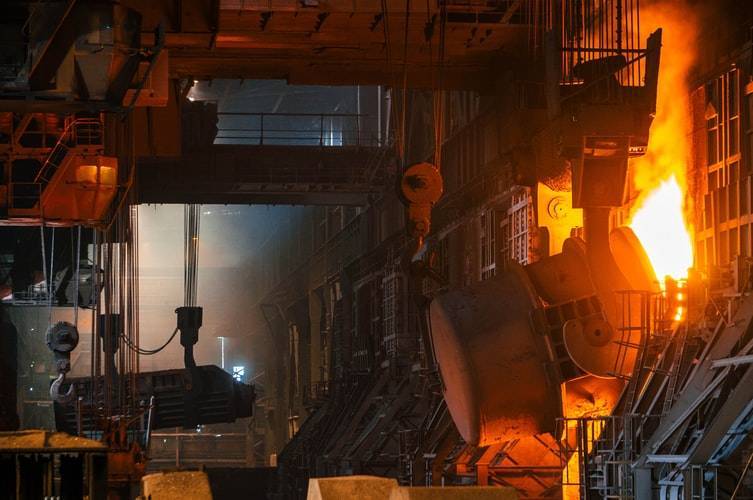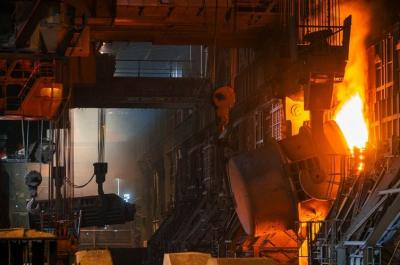The iron and steel industry is thriving unprecedentedly as the global economy recovers from the pandemic, with everyone feeling the cascading effects of this recovery on the steel industry—from home builders to appliance manufacturers. Steel is experiencing extremely high demand, pushing U.S. manufacturers to stop accepting customer orders in recent weeks, according to Dan DiMaria, sales manager at Heidtman Steel Products Inc. He stated, "Manufacturers may not start accepting new orders until late summer to manage accumulated deliveries."
Movements by raw material producers signal further delivery obstacles, potentially anticipating the rise of a commodity that is key to a wide range of industries globally, as the world economy is already shaken by supply shortages and inflation concerns, with individual consumption reaching 500 pounds of steel annually for needs ranging from paper clips and cars to skyscrapers. Steel prices in the United States have tripled in 12 months, surprising producers with a faster-than-expected economic recovery, while futures prices in China have reached record levels after authorities pledged to cut production in an effort to control emissions.
Steel prices have also risen in Europe, and imports may increase slightly, even if the U.S. raises the tariffs imposed by former President Donald Trump. Phil Gibbs, an analyst at KeyBanc Capital Markets in Cleveland, mentioned in a phone interview, "I have never seen such sharp and rapid movements, despite having witnessed frenzied movements during my nearly 15 years covering commodities." While prices of most commodities have risen, the 220% jump in U.S. steel prices last year outpaces increases in other commodities such as copper and crude oil.
The S&P steel index, which includes companies like Nucor Corp and Cleveland-Cliffs Inc., saw a 69% increase in 2021, marking the best performance during the first five months of the year. The recovery seemed unimaginable to steel executives just 10 months ago, who expected demand would not return to pre-pandemic levels until at least 2022. However, the rapid recovery and gradual resumption of steel production has depleted inventories that were already low during the pandemic's peak.
This situation mirrors what has happened with wood, which is also linked to the housing market, a sector where producers have faced pressure amid a sudden surge in housing demand, with wood being one of the few materials seeing gains similar to steel, forcing home builders to consider the impact of steel supply on their industry.
### Appliance Shortages
Carl Harris, who has spent 36 years building homes, reports two-month delays in delivering refrigerators, washing machines, and dishwashers. He noted that typical delivery times of two to three weeks have now stretched to half a year in many parts of the country. This delay means Harris cannot deliver homes he is working on due to incomplete installation of a set of appliances for a vacant two-bedroom house in Newton, outside Wichita, Kansas, despite the rest of the home being ready. Harris noted that other builders in the area are also struggling to get plumbing fixtures, which must be in place before occupancy certificates can be issued.
Harris, managing partner at Harris Homes in Wichita, stated in a phone call: "A lot of steel is used in appliances, so we’ve seen significant backlog in obtaining some appliances to enable us to deliver these homes. We are experiencing a major shortage." Additionally, drilling costs in the shale oil sector are rising, as increased prices for steel, cement, supplies, and other services lead to higher oil exploration costs, according to Citigroup, which indicated that prices for steel pipes used in new wells could rise by around 50% in 2021.
Executives from Ford Motor Company noted in a conference call discussing first-quarter results that the company saw increases in commodity prices for aluminum, steel, and precious metals. John T. Lawler, Ford’s chief financial officer, anticipated an increase of about $2.5 billion in commodity costs from the second to fourth quarters, stating, "We will be impacted if this continues for the rest of the year."
### Further Supply Availability
There are some signs that the supply crisis may ease, as U.S. steel manufacturers are expected to produce approximately 4.6 million tons annually in capacity by the end of 2022, an increase of about 4% from current levels. Moreover, rising prices have prompted President Joe Biden’s administration to consider removing tariffs imposed during Trump's presidency on steel imported from the European Union.
In China, the world's largest consumer and producer of steel, the government has repeatedly reaffirmed its commitment to curbing record production since late last year. However, the country’s mills are producing unprecedented amounts of steel. Currently, steel clients seeking immediate supplies must pay more or wait longer. DiMaria noted in an interview, "There are not many immediate deliveries as steel producers have restricted their orders, capping the number of orders they can fulfill to meet commitments."




